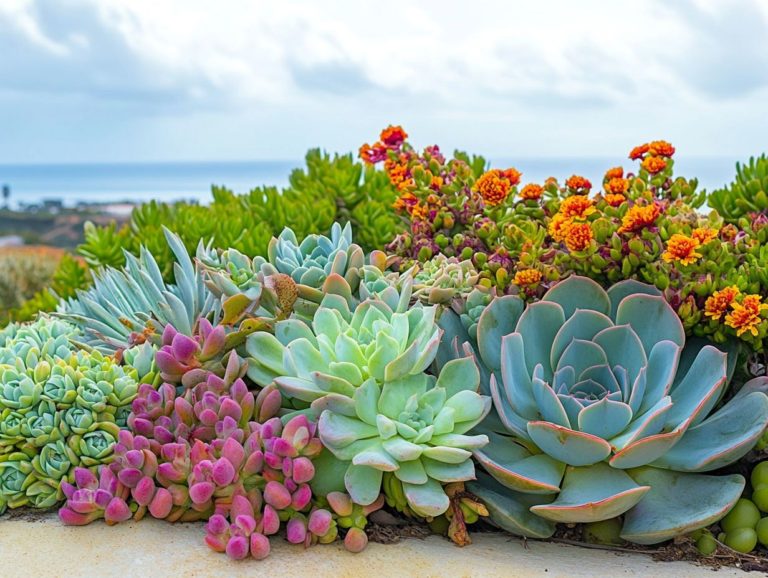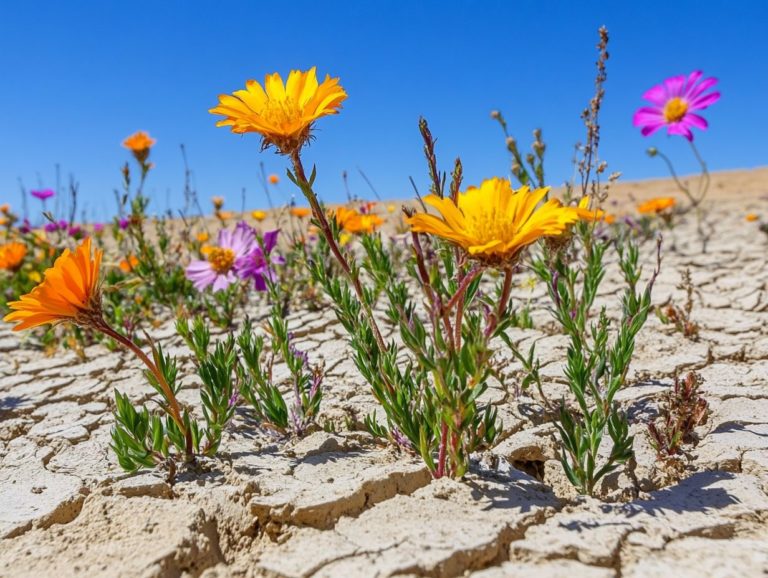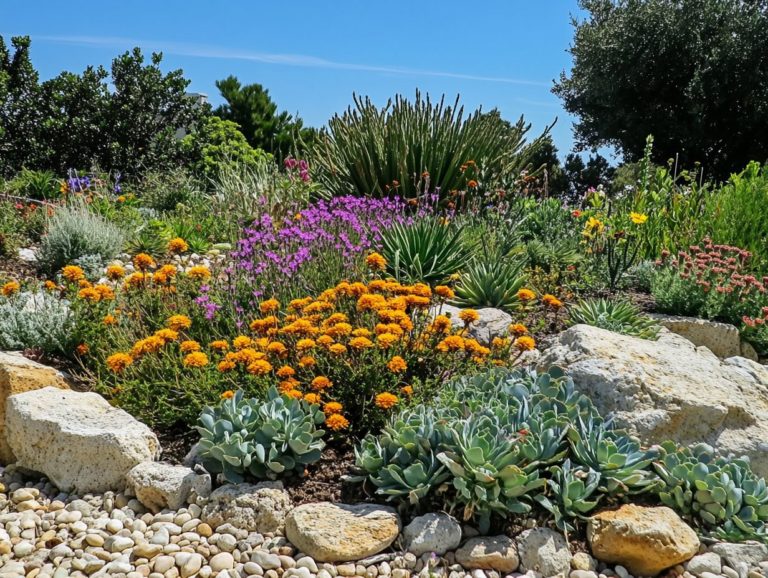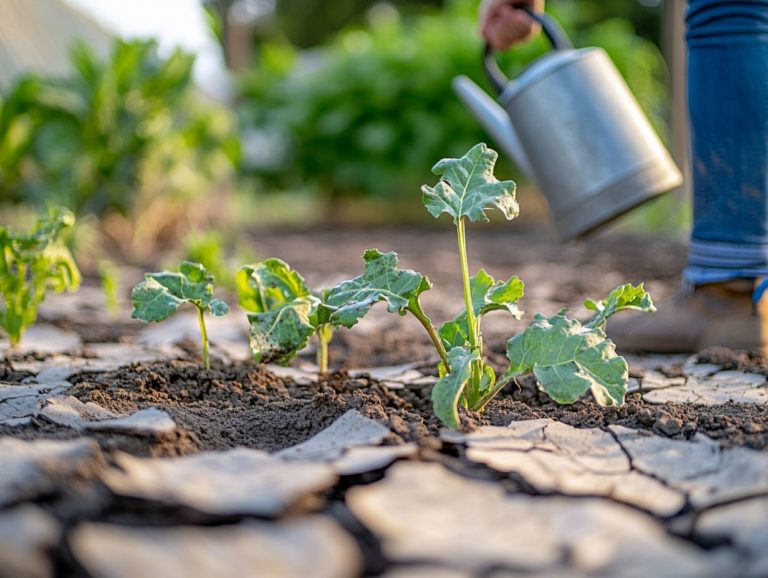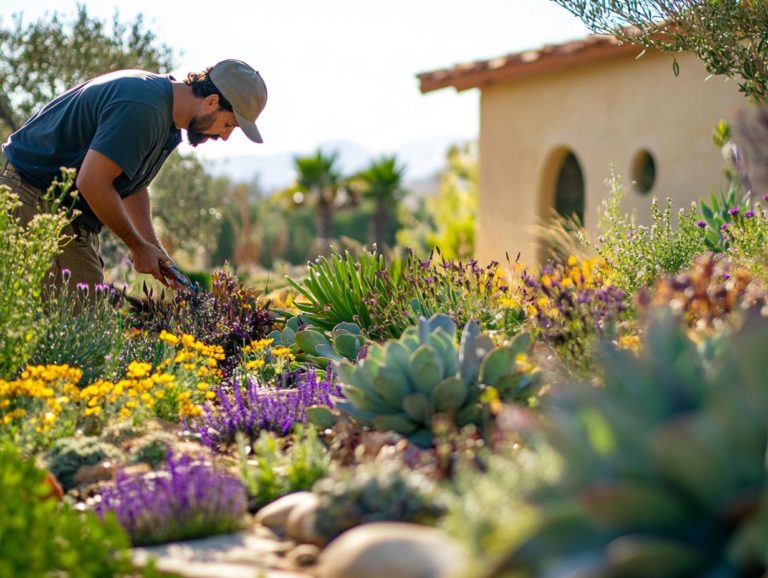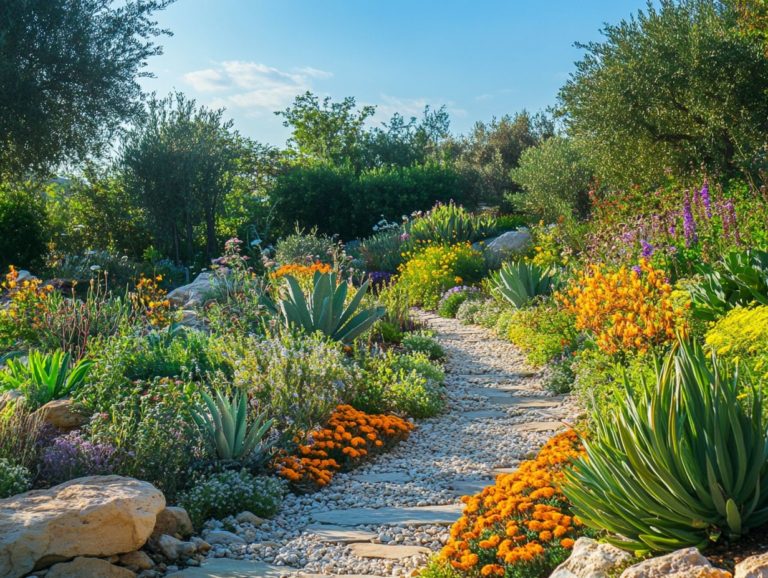Drought Gardening: Tips for Sustainable Practices
Climate change is reshaping our environment. Drought gardening is relevant for both seasoned gardeners and beginners.
This approach conserves water and encourages the use of resilient plants that can survive with little water. In this guide, you’ll discover what drought gardening entails, its environmental and economic benefits, and how to prepare your garden for dry spells effectively.
From choosing the right plants to mastering efficient watering techniques, uncover essential tips to cultivate a thriving, sustainable garden that withstands the challenges of drought.
Embrace the opportunity to create a greener, more resilient landscape.
Contents
- Key Takeaways:
- Understanding Drought Gardening
- Benefits of Drought Gardening
- Preparing for Drought Gardening
- Choosing Drought-Resistant Plants
- Watering Techniques for Drought Gardening
- Maintaining a Drought Garden
- Frequently Asked Questions
- What is drought gardening and why is it important?
- How can I prepare my garden for a drought?
- Why is mulching important for drought gardening?
- What are some water-efficient methods of watering during a drought?
- Can I still have a beautiful and productive garden during a drought?
- How can drought gardening benefit the environment?
Key Takeaways:
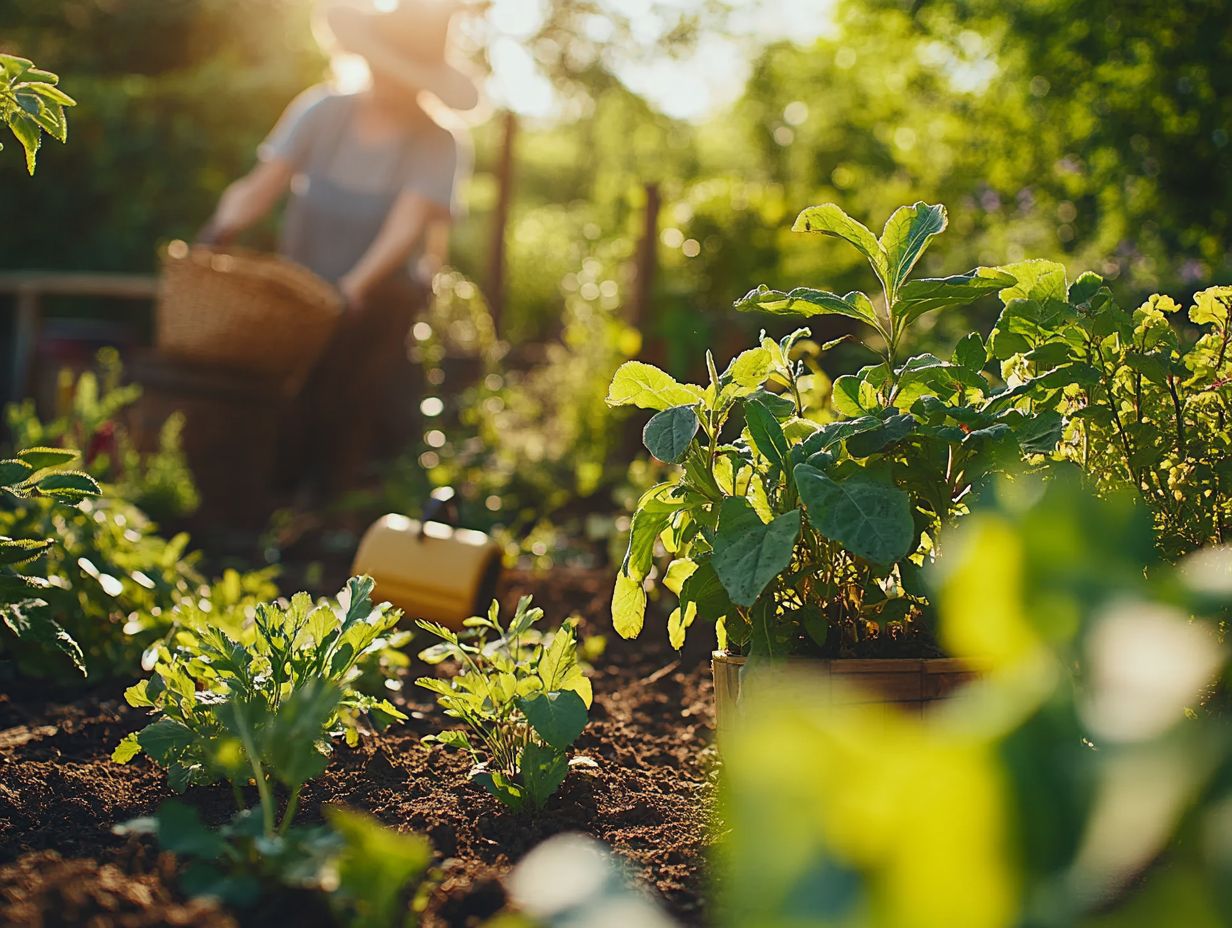
- Drought gardening is a sustainable way to maintain a garden during water scarcity, using efficient watering techniques and drought-resistant plants.
- Assessing soil and water needs is crucial for preparing and maintaining a successful drought garden.
- Drought gardening benefits the environment and has economic advantages, making it a wise choice for gardeners.
Understanding Drought Gardening
Understanding drought gardening is crucial for anyone aiming to cultivate a sustainable and resilient landscape, especially in water-sensitive regions like the Pacific Northwest. This approach prioritizes water-saving gardening techniques for drought and native plants, which not only require less water but also enrich biodiversity.
By embracing eco-friendly landscaping methods, you improve soil health, create habitats for pollinators, and ensure your garden flourishes even under challenging conditions. These strategies enhance your gardening experience and contribute significantly to the well-being of local ecosystems.
What is Drought Gardening?
Drought gardening encompasses various practices designed to nurture plants that thrive in low-water conditions, often blending organic methods with xeriscaping. For instance, understanding the environmental impact of drought-resistant gardening can further enhance your landscaping choices. Xeriscaping is a landscaping method that reduces the need for irrigation.
This innovative approach conserves precious water, fosters biodiversity, and enhances soil health. By choosing plants that can survive with little water, you can create vibrant landscapes that require minimal irrigation. Efficient landscaping techniques make wise use of natural resources, reducing the need for additional watering.
Integrating groundcovers into your designs is essential for preventing soil erosion, retaining moisture, and suppressing weeds. Embracing drought gardening supports sustainable practices that align with environmental stewardship, ensuring your garden remains lush and resilient in challenging climates.
Benefits of Drought Gardening
Discover the exciting environmental and economic benefits of drought gardening! This approach goes far beyond simply conserving water. By learning how to create a drought-resistant garden and embracing plants that can survive with little water, you play a significant role in preserving biodiversity and enhancing the carbon storage potential of your landscape.
This sustainable method minimizes the need for chemical inputs like organic fertilizers and cuts down on overall maintenance costs, making it a compelling choice for both novice and seasoned gardeners.
Cultivating habitats for beneficial organisms, like pollinators, contributes to a more balanced ecosystem, fostering a healthier environment overall.
Environmental and Economic Advantages
The environmental and economic benefits of drought gardening are remarkable, especially when considering sustainable practices that emphasize water conservation and biodiversity.
By adopting drought gardening techniques, you can cultivate a vibrant garden while significantly reducing water usage, an essential factor in regions dealing with water scarcity. Learning how to create a sustainable drought garden promotes the growth of native plants that thrive on minimal hydration, supporting local wildlife while helping you save money.
With less frequent watering, you ll enjoy reduced maintenance, which means a more efficient use of your time and resources. Ultimately, this harmonious approach fosters environmental sustainability and delivers real financial rewards, creating a win-win situation for the mindful gardener.
Don t miss out! Start your drought garden today to make a difference for the environment while saving money!
Preparing for Drought Gardening
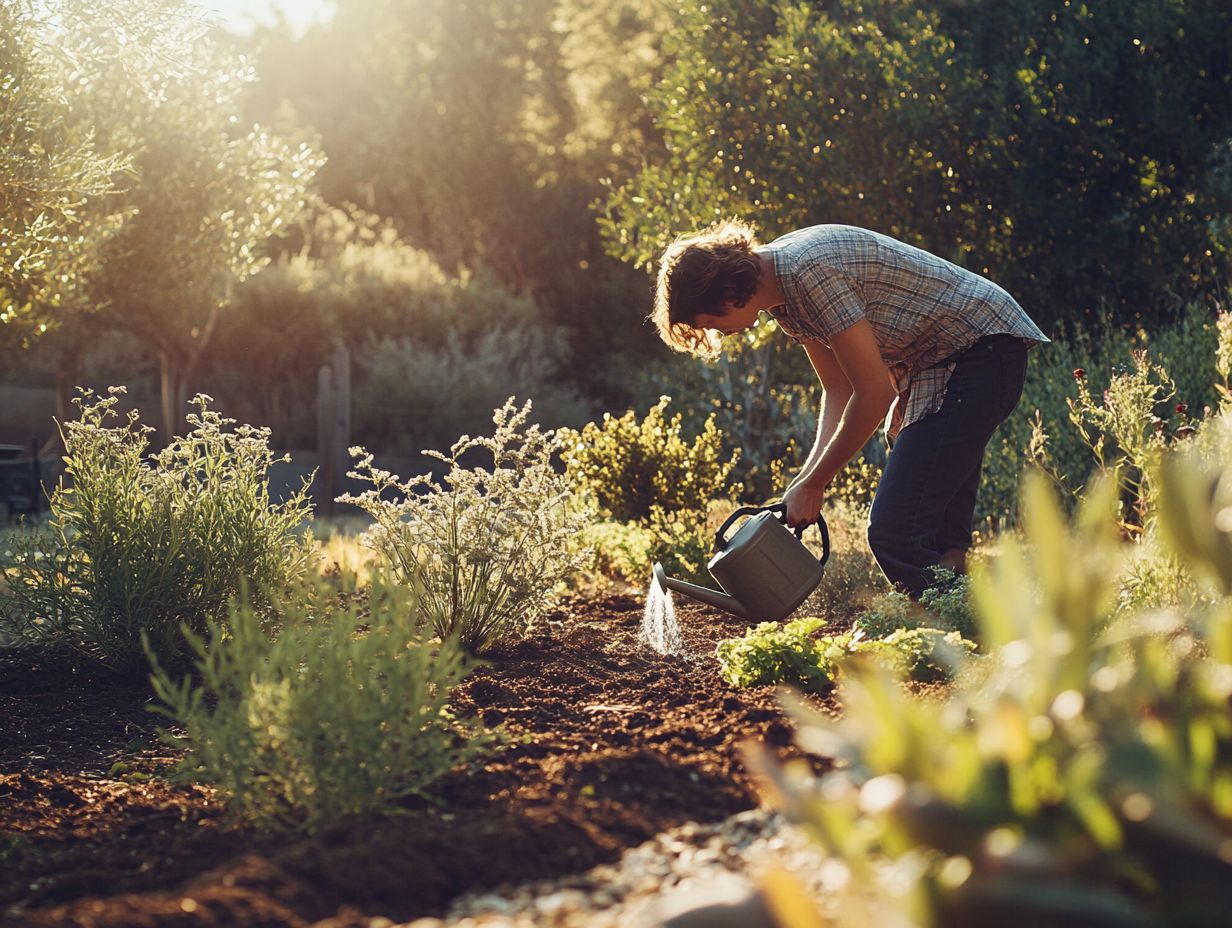
Preparing for drought gardening requires a meticulous assessment of soil quality and water needs. This foundational step is essential for establishing sustainable gardening practices, where nutrient-rich soil, enhanced with compost, effectively retains moisture. Incorporating innovative ideas for drought gardening can further optimize your efforts.
By understanding the specific water requirements of your chosen plants and adopting techniques like mulching, you can significantly bolster soil health and optimize your water conservation efforts.
Assessing Soil and Water Needs
Assessing your soil and water needs is a crucial step in creating a thriving drought garden. You need to carefully consider the existing soil conditions and the specific requirements of the plants you ve selected.
To effectively evaluate soil quality, conduct a simple texture test to see if your soil is sandy, clayey, or loamy. Using compost tea can enhance nutrient levels organically.
Pay attention to the soil s structure, how easily water can pass through, and biological activity; these factors provide valuable insights into its overall health. Understanding the unique water requirements of different plants is equally essential, as these needs can vary based on species and their growth stages.
Implementing practices that enhance erosion control, such as planting cover crops and utilizing mulch, will significantly contribute to sustaining soil health. These steps will help you create a resilient garden that can thrive in dry conditions.
Choosing Drought-Resistant Plants
Selecting drought-resistant plants is crucial for cultivating a resilient garden that flourishes even in low-water conditions. This choice enhances the beauty of your space and promotes biodiversity while nurturing local ecosystems, especially when you incorporate native plants.
Types of Plants to Consider
When selecting plants for drought gardening, consider opting for drought-tolerant species like groundcovers, native plants, and ornamental varieties such as roses, Hellebore, and lavender.
Incorporating these plants will help you create a vibrant garden that minimizes water usage. Native species, well-adapted to your local climate, often require less maintenance and demonstrate resilience against pests.
Ornamental plants add beauty and texture, enhancing the overall aesthetic of your space. Groundcovers, in particular, play a critical role in preventing soil erosion and maintaining soil health, serving as a protective layer over the earth.
To support thriving conditions for these plants, add compost to your soil. This enriches the soil, aids in moisture retention, and boosts nutrients during the establishment phase of these resilient species.
Watering Techniques for Drought Gardening
Implementing efficient watering techniques is essential for successful drought gardening. By doing so, you can maximize water efficiency, conserve precious water resources, and guarantee that your plants receive the moisture they require to flourish.
Efficient Watering Strategies
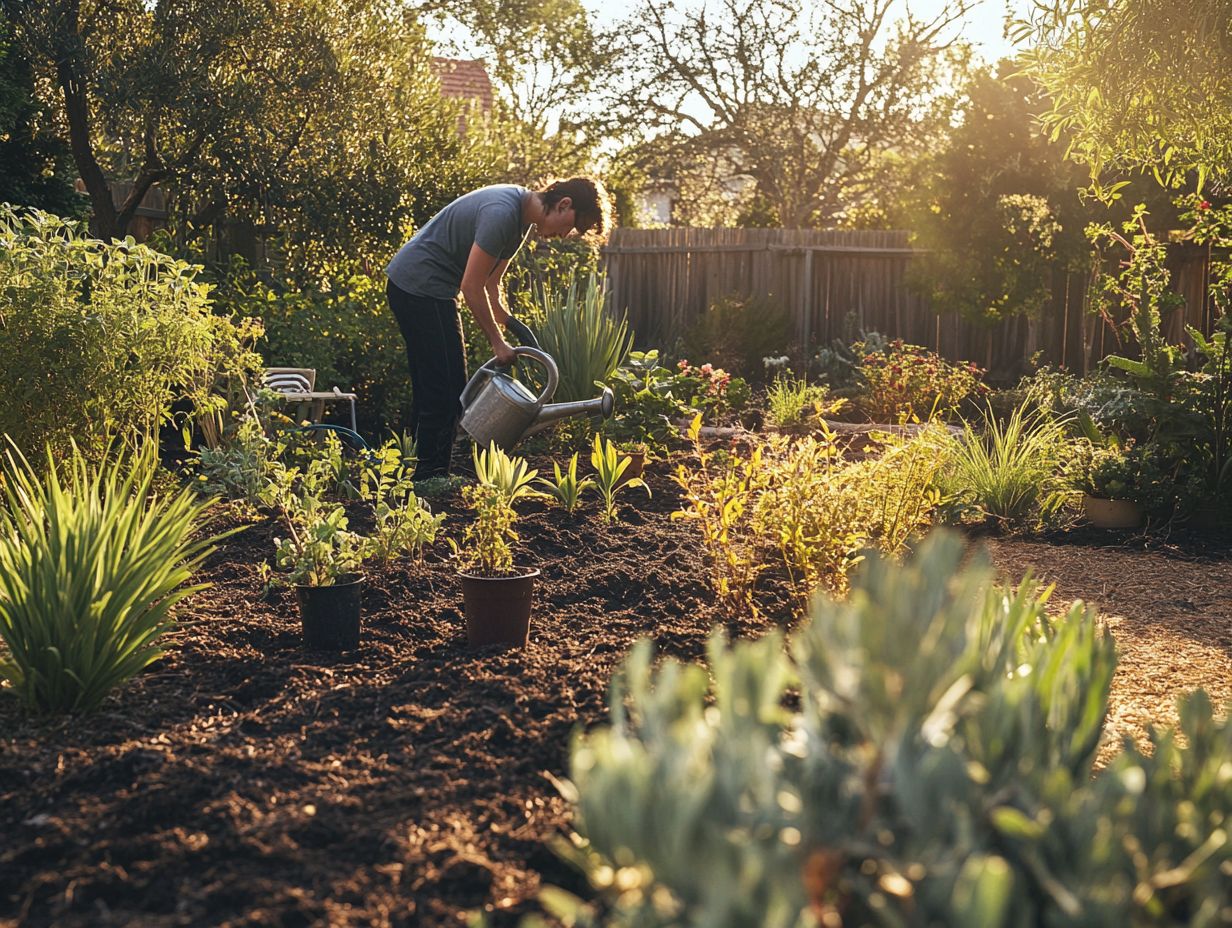
Efficient watering strategies are essential in drought gardening. Methods such as drip irrigation and the use of mulch are crucial for retaining moisture.
When you employ drip irrigation, you deliver water straight to the root zone, which minimizes evaporation. This guarantees that your plants receive the hydration they crave without any waste.
Incorporating compost enriches the soil and boosts its capacity to retain moisture, fostering a more sustainable environment for your plants to flourish. A generous layer of mulch serves as a protective barrier, reducing temperature fluctuations in the soil and keeping weeds at bay those pesky competitors for water.
Establishing a customized watering schedule tailored to the specific needs of your plants and the local climate is vital. This approach ensures that each plant thrives, especially during those particularly dry spells.
Maintaining a Drought Garden
Maintaining a drought garden requires a thoughtful approach, including drought-resistant gardening for small spaces. This involves a series of essential tasks and tips to keep your plants thriving and resilient.
By following organic practices and prioritizing soil health, you can create an environment where your garden flourishes even in challenging conditions.
Key Tips for Drought Gardening
Staying committed to essential tasks elevates your gardening experience. Regular maintenance is vital. Apply compost and mulch thoughtfully.
Effective pest management is crucial. Additionally, check on your plants and monitor their health regularly.
Your garden will benefit immensely from layering organic compost. This enriches the soil while significantly enhancing its moisture retention capabilities.
A generous layer of mulch serves as a protective barrier, minimizing evaporation and suppressing those pesky weeds that compete for your precious water resources.
Integrate organic strategies for pest control such as introducing beneficial insects or utilizing plant-based sprays to safeguard your plants’ vitality. Regularly check soil moisture levels to catch potential stressors early, enabling timely interventions that bolster the overall resilience of your low-water garden.
Frequently Asked Questions
What is drought gardening and why is it important?
Drought gardening is a game-changer. It conserves water and cuts down on the impact of drought on plant growth. This method reduces water usage effectively and promotes sustainable practices, especially when following resources like drought-resistant gardening: a community approach that benefit the environment.
How can I prepare my garden for a drought?
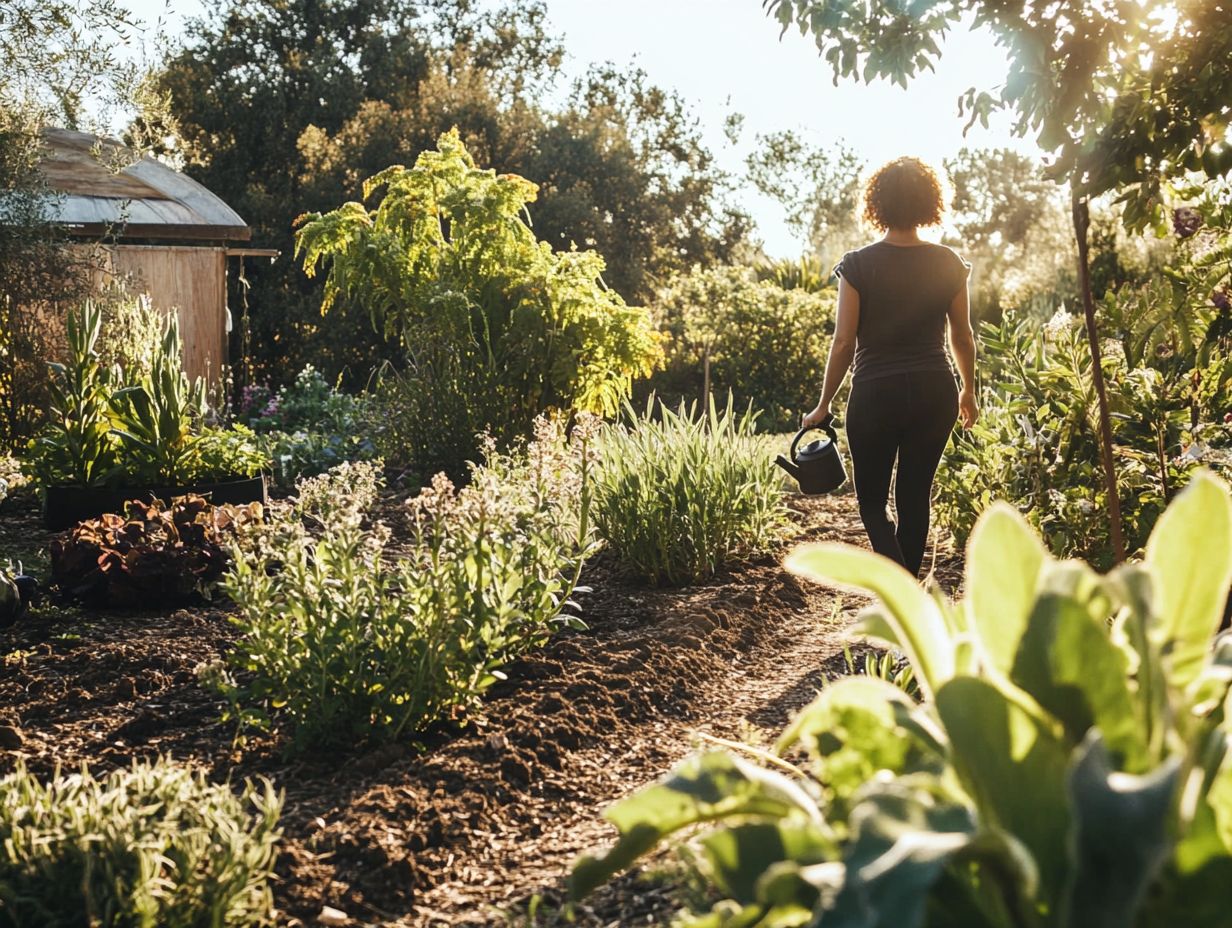
Prepare your garden for a drought by implementing sustainable practices like using mulch to retain soil moisture, choosing drought-resistant plants, and utilizing efficient watering methods such as drip irrigation. For more detailed information, check out the best practices for drought-resistant gardening. These practices can help your garden survive and thrive even during drought conditions.
Why is mulching important for drought gardening?
Mulching is crucial because it retains soil moisture and prevents water evaporation. It also helps suppress weeds, which compete with plants for water. Organic mulches like compost and bark can improve soil health and promote plant growth.
What are some water-efficient methods of watering during a drought?
Efficient methods of watering during a drought include drip irrigation, soaker hoses, and hand watering with a watering can. These methods deliver water directly to the plant’s roots, minimizing waste. Water deeply but infrequently to encourage plants to develop deep roots.
Can I still have a beautiful and productive garden during a drought?
Yes! You can maintain a beautiful and productive garden during a drought by selecting drought-resistant plants and using sustainable practices like mulching and efficient watering methods. With proper planning and care, your garden can thrive even in challenging conditions.
How can drought gardening benefit the environment?
Drought gardening benefits the environment by conserving water and reducing the use of resources like fertilizers and pesticides. It promotes healthier soil and supports local ecosystems by attracting pollinators and providing habitat for beneficial insects and wildlife.
Don’t wait! Start planning your drought garden today to ensure your plants thrive even in the toughest conditions.

